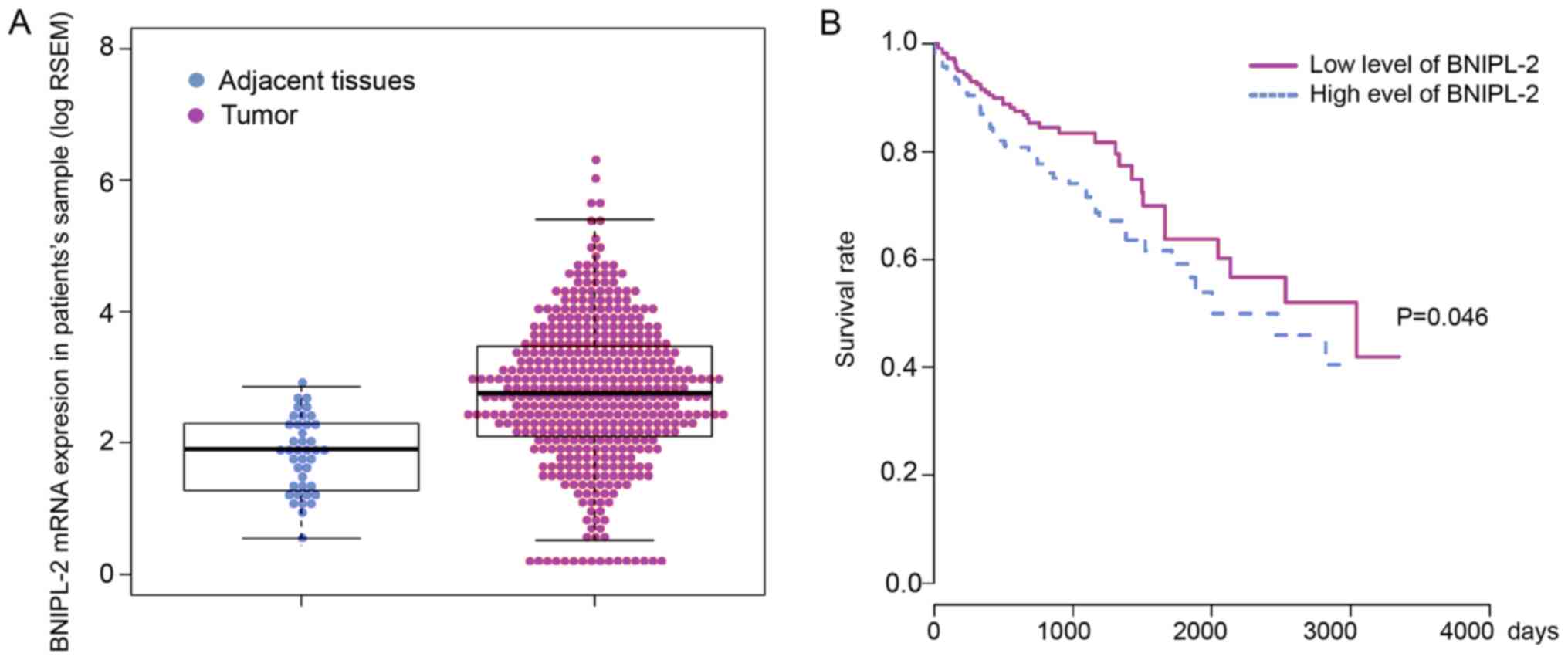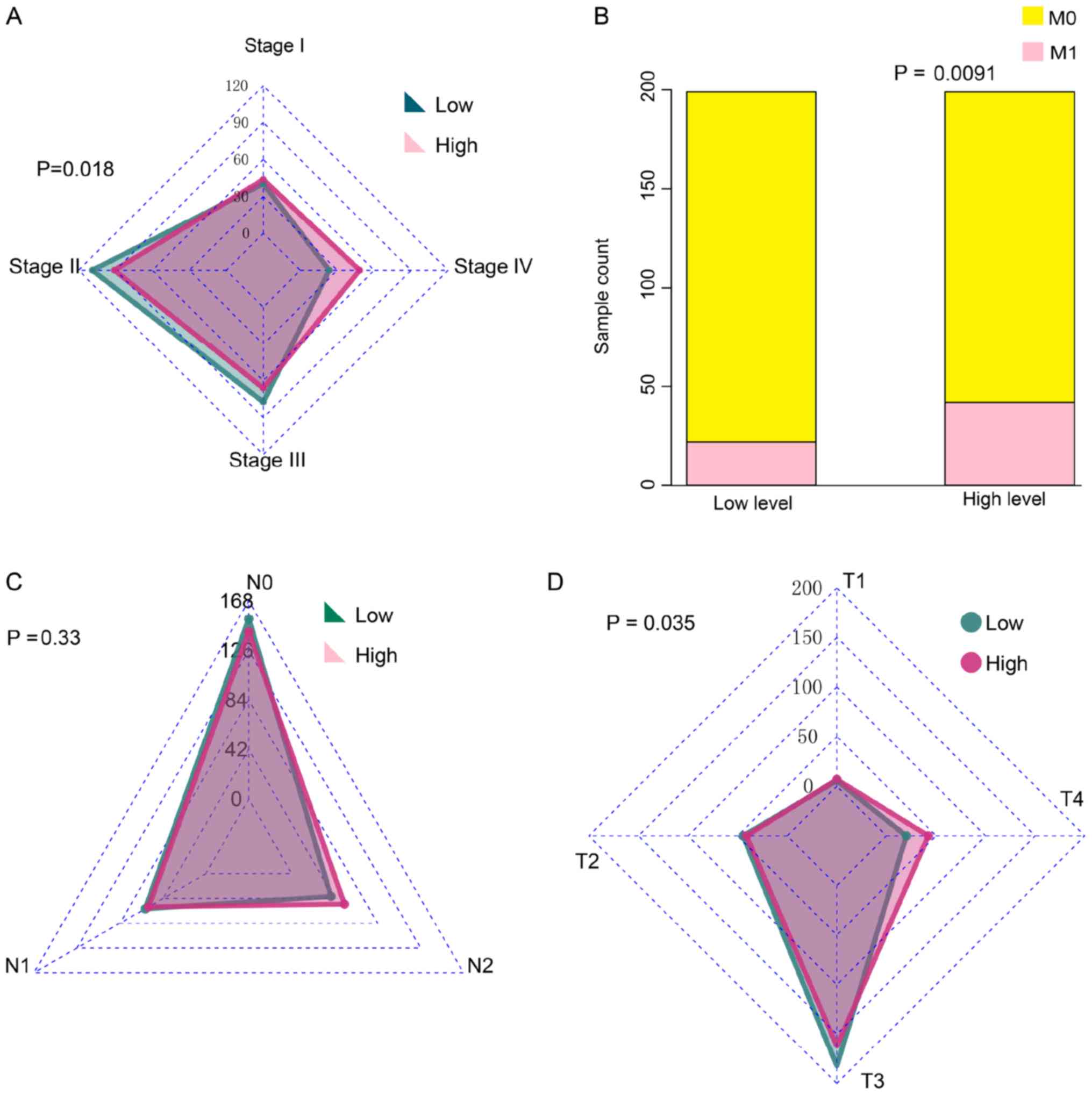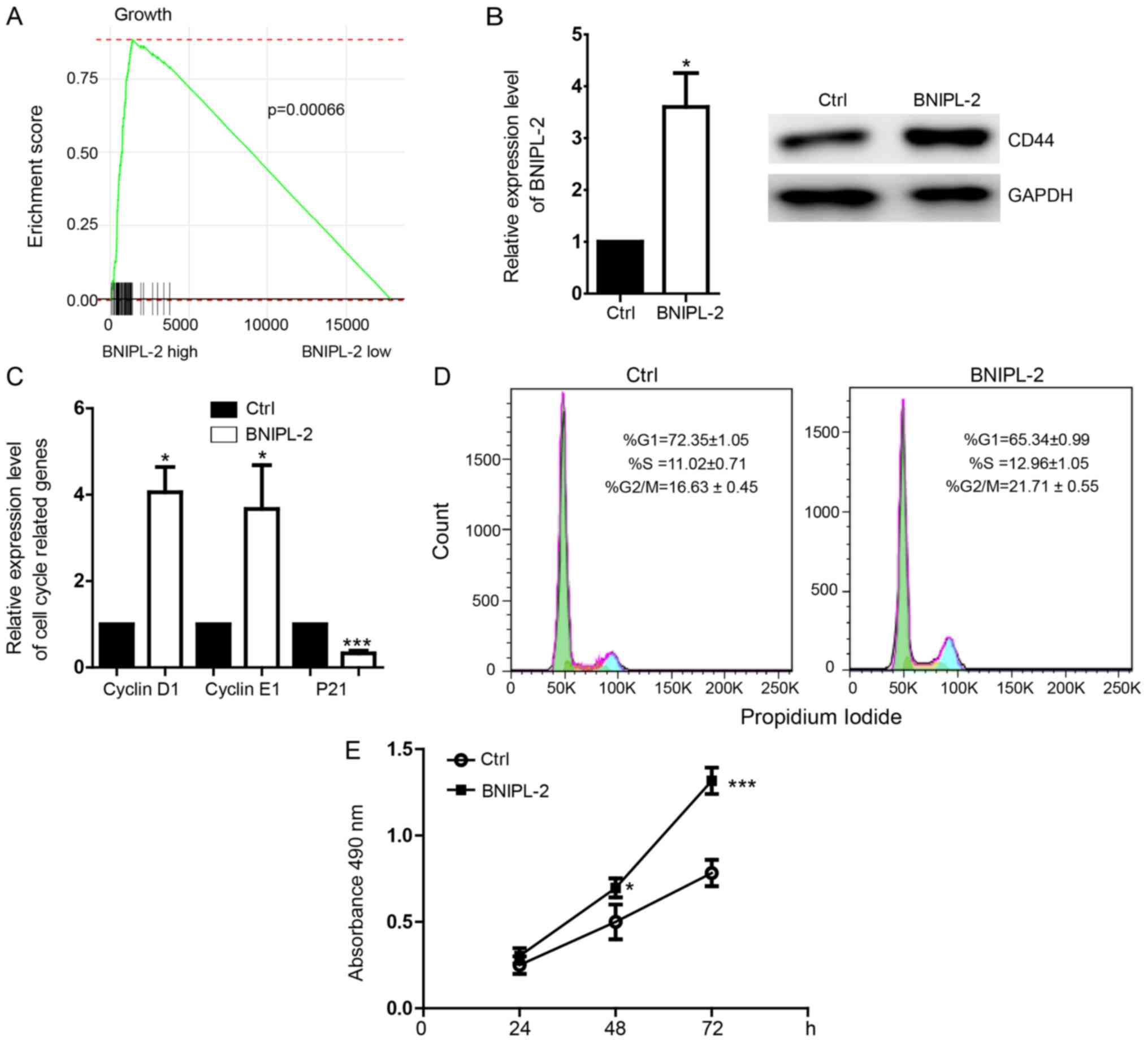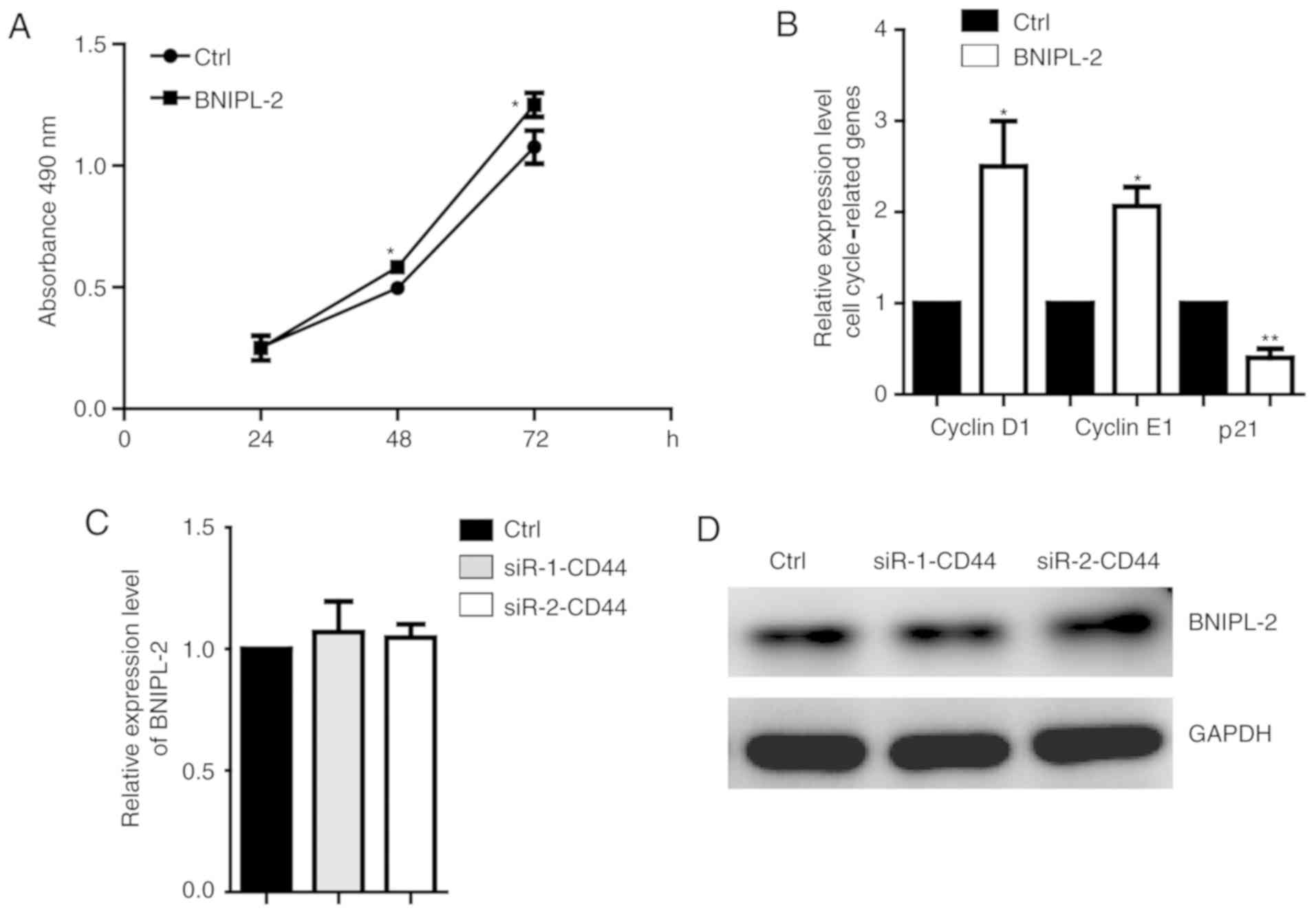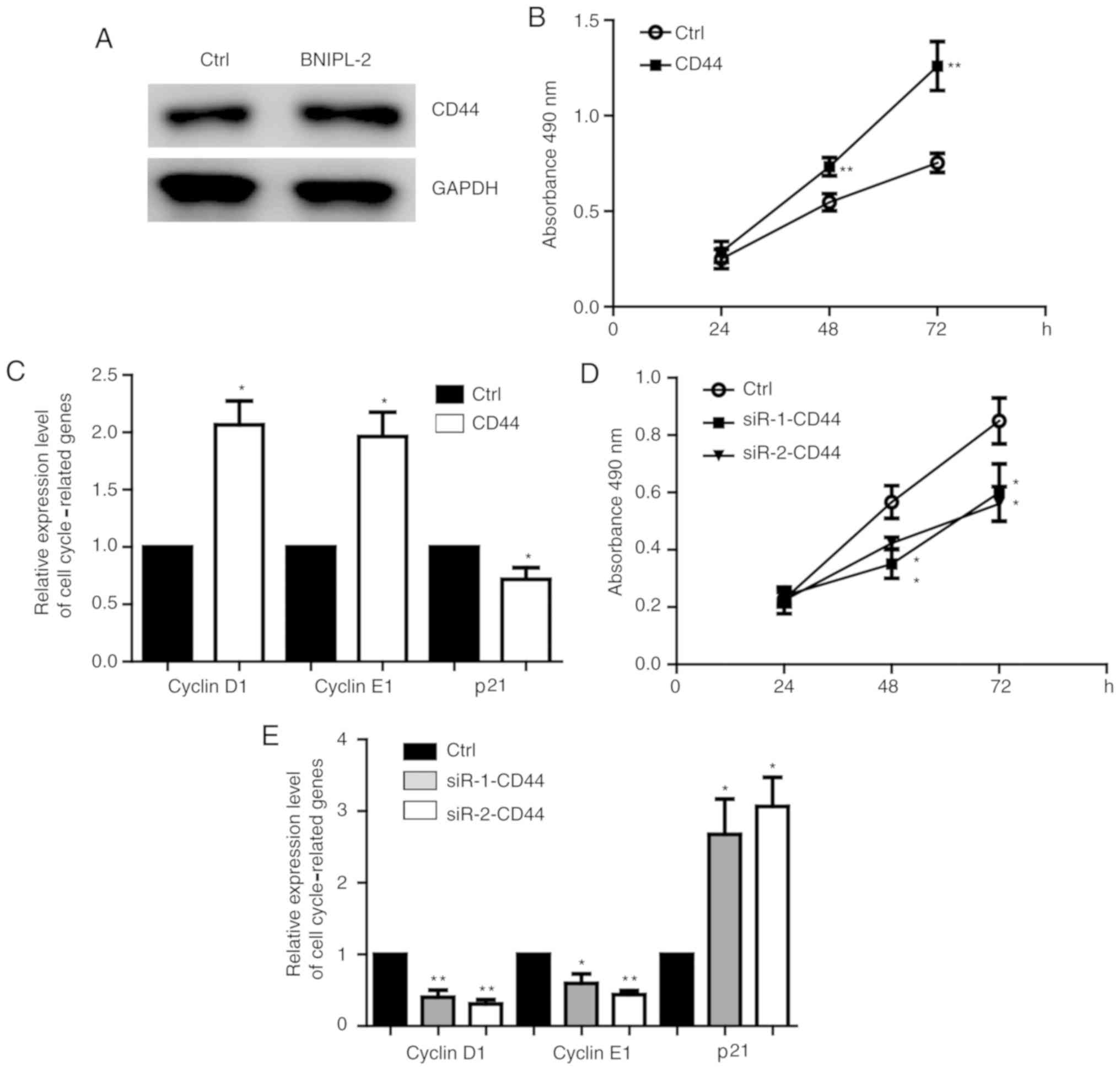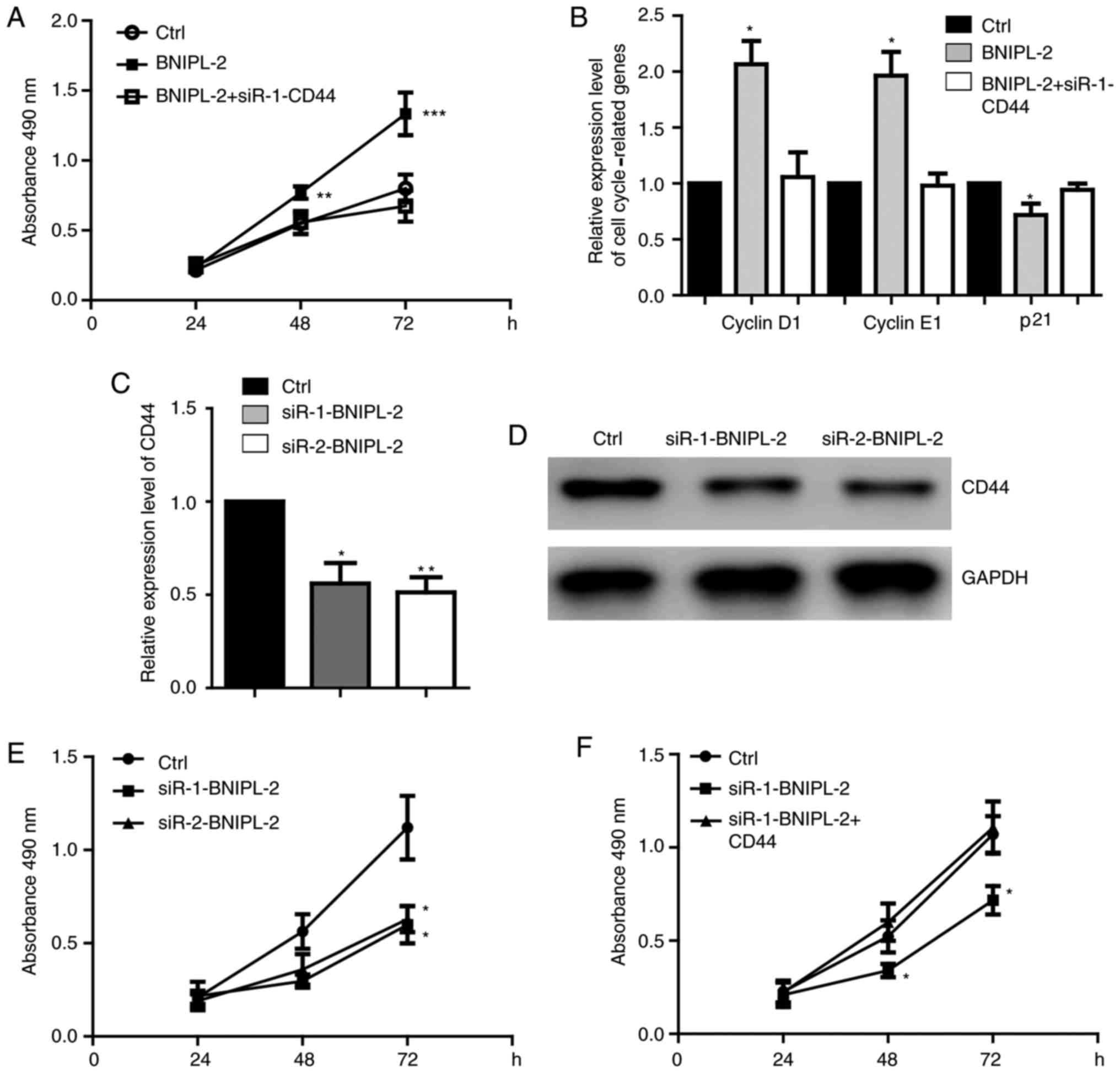BNIPL‑2 expression is correlated with the prognosis and regulates the proliferation of colorectal cancer through CD44
- Authors:
- Published online on: September 2, 2019 https://doi.org/10.3892/mmr.2019.10633
- Pages: 4073-4080
-
Copyright: © Gao et al. This is an open access article distributed under the terms of Creative Commons Attribution License.
Abstract
Introduction
Colorectal cancer (CRC) is the third most common cancer worldwide. Although there have been marked improvements in clinical treatment methods, CRC still causes many deaths every year, especially in developed countries (1,2). Great efforts to understand the complicated pathogenesis of CRC have been made, however it is still largely unknown, and critical regulatory molecules that are important for monitoring CRC tumor progression and detecting efficient therapeutic targets for future clinical treatments are required.
Rapid growth, migration and invasion are critical characteristics that induce malignant tumor genesis and development (3–5). Many signaling pathways have been reported to be closely related to these biological processes. For example, the upregulation of Sox2 in breast cancer tissues was associated with lymph node metastasis, pathological grade and TNM classification (6). Kisspeptin suppressed cancer growth and metastasis by activating EIF2AK2 in CRC (7). Cyclin D2/miR-1297 signaling was associated with the growth and metastasis of CRC (8). miR-184 inhibited cell proliferation and metastasis in CRC by targeting IGF-1R (9). MACC1 was identified as a biomarker of metastasis and disease prognosis (10). BNIPL-2 was revealed to interact with Bcl-2 and Cdc42GAP to regulate apoptosis in cells (11). Additionally, BNIPL-2 promoted cell migration, invasion and metastasis in hepatocellular carcinoma (HCC) cells (12). However, whether BNIPL-2 is also a potential critical regulator that is associated with CRC progression and prognosis remains largely unknown.
CD44 is reported to be an important regulator of cell proliferation. CD44 regulates endothelial cell proliferation by modulating CD31 and VE-cadherin (13). Knockdown of CD44 suppressed breast cancer cell proliferation (14). CD44 is also a potential biomarker for predicting hepatic metastases and survival (15). Upregulation of CD44 is associated with a metastatic CRC phenotype (16). However, whether CD44 directly regulates CRC proliferation and the related upstream regulators remains largely unknown.
It was hypothesized that BNIPL-2 and CD44 may regulate CRC proliferation, and the present study aimed to identify whether BNIPL-2 is associated with CRC prognosis and can be a potential biomarker by bioinformatics methods. The effects of BNIPL-2 and CD44 on cell cycle regulation and their regulatory relationship were also determined. In the present study, transcriptome data analysis of patient samples from the Cancer Genome Atlas (TCGA) dataset was performed to investigate potential gene expression correlations with CRC prognosis and progression. It was revealed that compared with that in adjacent tissues, BNIPL-2 was upregulated in CRC tissues. A higher expression level of BNIPL-2 was associated with greater malignant cancer progression and a poorer prognosis and was also closely correlated with the activation of signaling pathways involved in tumor growth, invasion and migration. The present study not only revealed the potential relationship between BNIPL-2 and CRC during CRC proliferation but also suggested the potential diagnostic value of BNIPL-2 as a biomarker and treatment target for CRC in future clinical therapy.
Materials and methods
Gene expression analysis of TCGA data
Data for the analysis of BNIPL-2 expression differences and the RSEM value of BNIPL-2-related regulatory signaling pathways in clinical CRC samples with related genome transcriptomic profiles were obtained online from TCGA (http://cancergenome.nih.gov/). All data regarding patients was obtained from TCGA.
Stratification of high or low levels of BNIPL-2 expression in patients
To determine the relationship between clinical malignancy stage, related signaling, and survival rate and BNIPL-2 expression in CRC patients, the CRC tissue samples were categorized according to high and low BNIPL-2 expression, as related to the median. Patients with higher BNIPL-2 expression than the median were classified into the high expression group, and those with lower BNIPL-2 expression than the median were classified into the low expression group.
Gene Set Enrichment Analysis (GSEA) using CRC tissues
GSEA was performed with the msigdb.v6.0.symbols.gmtgene set. A total of 10,000 permutations were used for P-value statistics.
Cell culture
The CRC cell lines SW480 and HCT116 were obtained from the American Type Culture Collection and cultured in DMEM (HyClone; GE Healthcare Life Sciences) supplemented with 10% FBS (Gibco; Thermo Fisher Scientific, Inc.). Cells were cultured at 37°C in an atmosphere with 5% CO2.
Overexpression of BNIPL-2
Total RNA was isolated from SW480 cells and used to synthesize cDNA with a reverse transcription PCR kit (Takara Bio, Inc.). The CDS sequence of BNIPL-2 mRNA was amplified from the cDNA and inserted into the Fugw vector (Addgene, Inc.). The primer sequences were as follows: forward, 5′-GGCGGATCCATGCGCAAGCGTCTTTCTGC-3′ (BamH1 site) and reverse, 5′-GGCGAATTCCTATGTCCCTCCTGAGCCATGGAG-3′ (EcoR1 site). The vector was transfected into cells to overexpress BNIPL-2 using Lipofectamine 2000 (Thermo Fisher Scientific, Inc.).
Knockdown of BNIPL-2
The siRNA sequences were as follows: Control siRNA, 5′-UUCUCCGAACGUCUCACGU-3′; siRNA-1-BNIPL-2,5′-CGCGUAGACAUGACUGUCAUU-3′; siRNA-2-BNIPL-2,5′-CCUUUGCAUGACCCUACUUUC-3′; and negative siRNA control, 5′-UUCUCCGAACGUGUCACGUTT-3′.
Knockdown of p53
siRNA-p53: Sense sequences 5′-GACUCCAGUGGUAAUCUACdTT-3′ [sequence was referenced by a previous study (17)] was transfected into HCT116 cells to downregulated p53 expression.
Overexpression of CD44
The CDS sequence of BNIPL-2 was amplified to insert into the Fugw vector. The primer sequences were as follows: Forward, 5′-GGCACCGGTATGGACAAGTTTTGGTGGCACG-3′ (Age1 site) and reverse, 5′-GGCGAATTCTTACACCCCAATCTTCATGTCCACA-3′ (EcoR1 site).
Knockdown of CD44
For CD44 knockdown, two siRNAs were used. The sense sequences for CD44 siRNA were as follows: siRNA control, 5′UUCUCCGAACGUCUCACGU-3′; siRNA-1-CD44, 5′-UGCCUUUGAUGGACCAAUU-3′; and siRNA-2-CD44, 5′-UAUUCCACGUGGAGAAAAATT-3′.
Flow cytometric assay
Cells were digested into a cell suspension and washed with PBS. Then, the cells were fixed with 70% alcohol at 4°C for 2 h. RNase A (20 mg/ml final concentration) was used to degrade whole RNA for 30 min at room temperature. Then, the cells were incubated with a propidium iodide solution (final concentration 50 mg/ml) for 15 min in the dark to stain the DNA. The cell cycle was analyzed using a Cytomics FC 500 instrument (Beckman Coulter, Inc.). The data were analyzed by FlowJo 7.6.1 software (FlowJo LLC).
Reverse transcription-quantitative (RT-q) PCR
Total RNA was isolated by RNAiso plus (Takara Biotechnology Co., Ltd.). cDNA was subsequently reverse-transcribed with M-MLV reverse transcriptase (Takara Biotechnology Co., Ltd.). RT-PCR included 40 cycles of amplification using SYBR Green qPCR mix (BioRad Laboratories, Inc.). Relative gene expression (2−ΔΔCq) (18) was normalized to GAPDH. The primer sequences used were as follows: GAPDH (forward, 5′-CTGGGCTACACTGAGCACC-3′ and reverse, 5′-AAGTGGTCGTTGAGGGCAATG-3′); cyclin E (forward, 5′-CGCCTGCCGGGACTGGAG-3′ and reverse, 5′-TCTTCCTGGAGCGAGCCG-3′); cyclin D (forward, 5′-GACCACCGAGGAGTTTAATCG-3′ and reverse, 5′-GGGTGATCCCCTGATCCTTTG-3′); p21 (forward, 5′-TGTCCGTCAGAACCCATGC-3′; and reverse, 5′-AAAGTCGAAGTTCCATCGCTC-3′); BNIPL-2 (forward, 5′-GAGTCTGACTAAGGGGCCTG-3′ and reverse, 5′-CTCCGAGTCTGAAGGTGTCT-3′); and CD44 (forward, 5′-TTGCTGCACAGATGGAGTTGG-3′ and reverse, 5′-GAAAGCTCTGAGCATCGGATTTG-3′). Thermocycling conditions were: Initial denaturation: 95°C for 30 sec, 95°C for 5 sec, 60 °C for 34 sec for 30 cycles.
Western blot analysis
Cells were lysed with SDS Lysis buffer (Beyotime Institute of Biotechnology, Inc.) and heated at 95°C for 10 min. A BCA Protein Assay Kit (Beyotime Institute of Biotechnology, Inc.) was used for protein amount determination. 10 µg protein was used for electrophoresis in agarose gel (12.5%; Epizyme, Inc.) Protein was transferred onto the PVDF membrane (Bio-Rad Laboratories, Inc.). The membrane was blocked by using 3% BSA (Epizyme, Inc.) for 1 h at room temperature and then incubated with primary antibodies against CD44 (Abcam, ab157107, Rabbit polyclonal antibody, 1:1,000 dilution), BNIPL-2 (Novus biologicals, NBP1-79502, Rabbit polyclonal antibody, 1:1,000 dilution) and GAPDH (Cell signaling technology, 14C10 2118, Rabbit polyclonal antibody, 1:2,000 dilution) respectively at room temperature for 2 h. Membrane was then incubated by secondary antibodies (Thermo, Inc, G-21234, 1:3,000 dilution) at room temperature for 1 h. Results for signaling visualization was detected by enhanced chemiluminescence (ECL) western blotting substrate (Thermo, Inc.) and analyzed using the Bio-Rad ChemiDoc system (Bio-Rad Laboratories, Inc.).
Cell proliferation analysis
Cells were seeded at a density of 3×103 cells/well) in 96-well plates and used to perform a proliferation assay according to the Cell Titer 96 AQueous One Solution Cell Proliferation Assay instructions (MTS) (Promega Corporation). A microplate reader was used to detect the absorbance at 490 nm.
Statistical analysis
T-tests were used to determine statistical significance. Fisher's exact test was used to determine TMN stage differences. Prognosis analysis was performed using the Kaplan-Meier method. The values are presented as the mean ± standard deviation. P<0.05, P<0.01 and P<0.001 were considered to indicate statistically significant differences.
Results
BNIPL-2 is upregulated in CRC tissues and correlated with poor prognosis
To determine whether BNIPL-2 expression was associated with CRC, the expression level of BNIPL-2 was analyzed in 41 adjacent tissue samples and 459 cancer samples from TCGA and significantly higher BNIPL-2 levels were revealed in CRC samples than in adjacent tissues (Fig. 1A). A Kaplan-Meier survival curve was used to analyze whether the different levels of BNIPL-2 expression were related to the prognosis of CRC patients. Patients were assigned into two groups corresponding to low and high BNIPL-2 expression, which was defined according to the median patient expression, and it was revealed that there was a significantly poorer survival rate for the high BNIPL-2 expression group than for the low BNIPL-2 expression group. Additionally, the five-year survival rate of patients with low expression of BNIPL-2 was approximately 10% higher than that of patients with high BNIPL-2 expression (Fig. 1B).
High expression of BNIPL-2 is associated with the malignant stage characteristics of CRC
Due to the relationship between high BNIPL-2 expression and poor prognosis, it was hypothesized that BNIPL-2 expression would be associated with malignant stage characteristics. It was revealed that tissues with higher expression of BNIPL-2 stratified at the more adverse stage IV, whereas tissues with lower levels of BNIPL-2 stratified at stages II and III (Fig. 2A). TNM staging was further analyzed and it was revealed that there were more tissues with high BNIPL-2 expression classified as M1 than as M0 compared to low BNIPL-2 expression (Fig. 2B). There was no significant difference between BNIPL-2 expression and N staging classification (Fig. 2C). However, T staging analysis revealed that more cancer tissues with high BNIPL-2 expression were in the T4 stage than CRC tissues with low BNIPL-2 expression (Fig. 2D).
BNIPL-2 promotes the proliferation of the CRC cell line SW480
The tumor genesis- and development-related regulatory pathways associated with BNIPL-2 expression were detected in CRC transcriptomic profiles by gene set enrichment analysis (GSEA) and the results revealed that the cell migration-related signaling pathway was activated in BNIPL-2 high-expression tissues but not in BNIPL-2 low-expression tissues (Fig. 3A). Overexpression of BNIPL-2 (Fig. 3B) in SW480 cells upregulated the expression of cyclin D1 and cyclin E1 and downregulated the expression of the cell cycle inhibitor p21 (Fig. 3C). The proportion of cells was decreased in the G1 phase and increased in the S and G2/M phases by the overexpression of BNIPL-2 (Fig. 3D). An MTS proliferation assay revealed that cell proliferation was promoted by BNIPL-2 overexpression (Fig. 3E).
BNIPL-2 also promotes the proliferation of the CRC cell line HCT116
To further confirm the function of BNIPL-2 in regulating CRC proliferation, BNIPL-2 was overexpressed in another CRC cell line, HCT116, and the results revealed that proliferation was also promoted (Fig. 4A). The critical cell cycle-related genes cyclin D1 and cyclin E1 were higher, and p21 was lower in BNIPL-2-overexpressing cells than in control cells (Fig. 4B). Downregulation of CD44 did not induce changes in BNIPL-2 mRNA (Fig. 4C) and protein (Fig. 4D) expression, which suggested that there was no reverse regulation of BNIPL-2 and CD44.
CD44 is regulated by BNIPL-2 and promotes CRC proliferation
Overexpression of BNIPL-2 increased the protein level of CD44 in SW480 cells (Fig. 5A). Overexpression of CD44 (Fig. S1A) promoted SW480 cell proliferation (Fig. 5B) and increased the expression of the cell cycle-related genes cyclin D1 and E1 and decreased the expression of p21 (Fig. 5C). CD44 knockdown (Fig. S1B) inhibited proliferation (Fig. 5D), increased p21 expression and decreased cyclin D1 and E1 expression (Fig. 5E). In order to demonstrate the effect of transfection, a positive siRNA experimental group was also employed. siRNA-p53 [sequence was referenced by a previous study (17)] was transfected into HCT116 cells and the downregulation of p53 was detected to confirm the effective transfection system (Fig. S1C). It was further determined that CD44 overexpression (Fig. S1D) promoted HCT116 cell proliferation (Fig. S1E), and CD44 knockdown (Fig. S1F) suppressed HCT116 cell proliferation (Fig. S1G).
CD44 mediates the function of BNIPL-2 in regulating CRC proliferation
A rescue experiment was then performed to detect whether BNIPL-2 promotes cell proliferation through CD44. It was revealed that CD44 knockdown significantly blocked the promotion of proliferation caused by overexpressing BNIPL-2 in SW480 cells (Figs. 6A and S2A). The expression of cell cycle-regulated genes was also restored by CD44 downregulation (Fig. 6B). BNIPL-2 knockdown downregulated CD44 at the mRNA (Fig. 6C) and protein levels (Fig. 6D) and inhibited cell proliferation (Fig. 6E). CD44 overexpression rescued the proliferation caused by BNIPL-2 knockdown in both SW480 cells (Fig. 6F) and HCT116 cells (Fig. S2B and C).
Discussion
Colorectal cancer has become one of the most frequent types of malignant cancers worldwide (2). An improved understanding of the risk factors of CRC is of great importance to improve the future diagnosis and treatment of the disease. In the present study, it was revealed that a high level of BNIPL-2 is a critical factor involved in the adverse T and M stages and poor prognosis and is correlated with cell growth, migration, and invasion regulatory signaling pathways.
BNIPL-2 has been reported to promote the invasion and metastasis of human hepatocellular carcinoma cells (12). However, apoptosis and growth inhibition-related genes were upregulated, and cellular proliferation was downregulated in Hep3B cells overexpressing BNIPL-2 (19). These studies indicated the complicated function of BNIPL-2 in regulating cancer physiology. It was revealed that upregulation of BNIPL-2 in CRC tissues suggested a poor prognosis. These results are the first to indicate the critical relationship between BNIPL-2 and CRC.
BNIPL-2 interacts with Bcl-2 and Cdc42GAP (11), which are both important apoptosis- and proliferation-related genes in many types of cancers (20,21). These studies indicated the critical regulatory function of BNIPL-2 in cancer cell growth. TMN stage analysis was performed and a correlation between higher BNIPL-2 expression levels and adverse T and M stages was revealed, which suggested the potential function of BNIPL-2 in the regulation of cell growth involved in proliferation and apoptosis. It was further detected that gene enrichment for tumor genesis and development, including cell growth, migration, and invasion, were all stratified in the BNIPL-2 high expression tissues. BNIPL-2 was also critically involved in regulating CRC cell proliferation. BNIPL-2 upregulated the expression of cyclin D1 and cyclin E1 and downregulated the expression of p21. The proportion of cells was increased in the G1 phase and decreased in the S and G2/M phases upon overexpression of BNIPL-2. The present results indicated the critical function of BNIPL-2 in regulating CRC proliferation and cell cycle processes.
CD44 has been reported to promote cell proliferation in non-small cell lung cancer (16). νCD44 regulated proliferation in lung cancer PDL cells, possibly through BMP-2, FGF-1 and ICAM-1 (22). In cutaneous squamous cells, miR-199a targeted CD44 and reduced proliferation (23). These studies indicated the function of CD44 in regulating cell proliferation. In the present study, it was confirmed that CD44 mediated the function of BNIPL-2 in regulating CRC proliferation. BNIPL-2/CD44 signaling plays an important role during CRC growth.
Additionally, there are some limitations to this study. It will further be determined whether BNIPL-2 can be a transcriptional factor that regulates the expression of CD44 by ChIP and luciferase reporter gene assays in the future. Additionally, the BNIPL-2/CD44 signaling axis regulation of CRC cell proliferation in vivo will be verified. The present results not only indicated the important roles of BNIPL-2 in CRC genesis and development and cell cycle and proliferation regulation but also suggested the potential function of BNIPL-2 as an efficient biomarker or treatment target for future therapy.
Supplementary Material
Supporting Data
Acknowledgements
Not applicable.
Funding
The present study was supported by the National Natural Science Foundation of China (grant nos. 81801047 and U1404808).
Availability of data and materials
The datasets used and/or analyzed during the current study are available from the corresponding author on reasonable request.
Authors' contributions
LG and HL performed most of the cell and molecular experiments. NY, SZ and GJ conceived and performed the experiments and analyzed the data. YH, DH and YL performed the bioinformatics analysis. QS and XF conceived and supervised the project and wrote the manuscript. All authors read and approved the final manuscript.
Ethics approval and consent to participate
Not applicable.
Patient consent for publication
Not applicable.
Competing interests
The authors declare that they have no competing interests.
References
|
Farinetti A, Zurlo V, Manenti A, Coppi F and Mattioli AV: Mediterranean diet and colorectal cancer: A systematic review. Nutrition. 43-44:83–88. 2017. View Article : Google Scholar : PubMed/NCBI | |
|
Siegel R, Ma J, Zou Z and Jemal A: Cancer statistics, 2014. CA Cancer J Clin. 64:9–29. 2014. View Article : Google Scholar : PubMed/NCBI | |
|
Xu C, He T, Li Z, Liu H and Ding B: Regulation of HOXA11-AS/miR-214-3p/EZH2 axis on the growth, migration and invasion of glioma cells. Biomed Pharmacother. 95:1504–1513. 2017. View Article : Google Scholar : PubMed/NCBI | |
|
Huang XQ, Zhang XF, Xia JH, Chao J, Pan QZ, Zhao JJ, Zhou ZQ, Chen CL, Tang Y, Weng DS, et al: Tripartite motif-containing 3 (TRIM3) inhibits tumor growth and metastasis of liver cancer. Chin J Cancer. 36:772017. View Article : Google Scholar : PubMed/NCBI | |
|
Zhao Z, Jia Q, Wu MS, Xie X, Wang Y, Song G, Zou CY, Tang Q, Lu J, Huang G, et al: Degalactotigonin, a natural compound from Solanum nigrum L., inhibits growth and metastasis of osteosarcoma through GSK3β inactivation-mediated repression of the Hedgehog/Gli1 pathway. Clin Cancer Res. 24:130–144. 2018. View Article : Google Scholar : PubMed/NCBI | |
|
Li XT, Liang Z, Wang TT, Yang JW, Ma W, Deng SK, Wang XB, Dai YF, Guo JH and Li LY: Brain-derived neurotrophic factor promotes growth of neurons and neural stem cells possibly by triggering the phosphoinositide 3-kinase/AKT/glycogen synthase kinase-3β/β-catenin pathway. CNS Neurol Disord Drug Targets. 16:828–836. 2017. View Article : Google Scholar : PubMed/NCBI | |
|
Kim TH and Cho SG: Kisspeptin inhibits cancer growth and metastasis via activation of EIF2AK2. Mol Med Rep. 16:7585–7590. 2017. View Article : Google Scholar : PubMed/NCBI | |
|
Wang Y, Xue J, Kuang H, Zhou X, Liao L and Yin F: microRNA-1297 inhibits the growth and metastasis of colorectal cancer by suppressing cyclin D2 expression. DNA Cell Biol. 36:991–999. 2017. View Article : Google Scholar : PubMed/NCBI | |
|
Wu G, Liu J, Wu Z, Wu X and Yao X: MicroRNA-184 inhibits cell proliferation and metastasis in human colorectal cancer by directly targeting IGF-1R. Oncol Lett. 14:3215–3222. 2017. View Article : Google Scholar : PubMed/NCBI | |
|
Lu H, Liufu N, Dong Y, Xu G, Zhang Y, Shu L, Soriano SG, Zheng H, Yu B and Xie Z: Sevoflurane acts on ubiquitination-proteasome pathway to reduce postsynaptic density 95 protein levels in young mice. Anesthesiology. 127:961–975. 2017. View Article : Google Scholar : PubMed/NCBI | |
|
Qin W, Hu J, Guo M, Xu J, Li J, Yao G, Zhou X, Jiang H, Zhang P, Shen L, et al: BNIPL-2, a novel homologue of BNIP-2, interacts with Bcl-2 and Cdc42GAP in apoptosis. Biochem Biophys Res Commun. 308:379–385. 2003. View Article : Google Scholar : PubMed/NCBI | |
|
Xie L, Qin W, Li J, He X, Zhang H, Yao G, Shu H, Yao M, Wan D and Gu J: BNIPL-2 promotes the invasion and metastasis of human hepatocellular carcinoma cells. Oncol Rep. 17:605–610. 2007.PubMed/NCBI | |
|
Tsuneki M and Madri JA: CD44 regulation of endothelial cell proliferation and apoptosis via modulation of CD31 and VE-cadherin expression. J Biol Chem. 289:5357–5370. 2014. View Article : Google Scholar : PubMed/NCBI | |
|
Nam K, Oh S, Lee KM, Yoo SA and Shin I: CD44 regulates cell proliferation, migration, and invasion via modulation of c-Src transcription in human breast cancer cells. Cell Signal. 27:1882–1894. 2015. View Article : Google Scholar : PubMed/NCBI | |
|
Jing F, Kim HJ, Kim CH, Kim YJ, Lee JH and Kim HR: Colon cancer stem cell markers CD44 and CD133 in patients with colorectal cancer and synchronous hepatic metastases. Int J Oncol. 46:1582–1588. 2015. View Article : Google Scholar : PubMed/NCBI | |
|
Elliott VA, Rychahou P, Zaytseva YY and Evers BM: Activation of c-Met and upregulation of CD44 expression are associated with the metastatic phenotype in the colorectal cancer liver metastasis model. PLoS One. 9:e974322014. View Article : Google Scholar : PubMed/NCBI | |
|
Wang S, Wang K, Zhang C, Zhang W, Xu Q, Wang Y, Zhang Y, Li Y, Zhang Y, Zhu H, et al: Overaccumulation of p53-mediated autophagy protects against betulinic acid-induced apoptotic cell death in colorectal cancer cells. Cell Death Dis. 8:e30872017. View Article : Google Scholar : PubMed/NCBI | |
|
Livak KJ and Schmittgen TD: Analysis of relative gene expression data using real-time quantitative PCR and the 2(-Delta Delta C(T)) method. Methods. 25:402–408. 2001. View Article : Google Scholar : PubMed/NCBI | |
|
Xie L, Qin WX, He XH, Shu HQ, Yao GF, Wan DF and Gu JR: Differential gene expression in human hepatocellular carcinoma Hep3B cells induced by apoptosis-related gene BNIPL-2. World J Gastroenterol. 10:1286–1291. 2004. View Article : Google Scholar : PubMed/NCBI | |
|
Li Q, Peng J, Liu T and Zhang G: Effects of celecoxib on cell apoptosis and Fas, FasL and Bcl-2 expression in a BGC-823 human gastric cancer cell line. Exp Ther Med. 14:1935–1940. 2017. View Article : Google Scholar : PubMed/NCBI | |
|
Shi C, Ren L, Sun C, Yu L, Bian X, Zhou X, Wen Y, Hua D, Zhao S, Luo W, et al: miR-29a/b/c function as invasion suppressors for gliomas by targeting CDC42 and predict the prognosis of patients. Br J Cancer. 117:1036–1047. 2017. View Article : Google Scholar : PubMed/NCBI | |
|
Yeh Y, Yang Y and Yuan K: Importance of CD44 in the proliferation and mineralization of periodontal ligament cells. J Periodontal Res. 49:827–835. 2014. View Article : Google Scholar : PubMed/NCBI | |
|
Wang SH, Zhou JD, He QY, Yin ZQ, Cao K and Luo CQ: MiR-199a inhibits the ability of proliferation and migration by regulating CD44-Ezrin signaling in cutaneous squamous cell carcinoma cells. Int J Clin Exp Pathol. 7:7131–7141. 2014.PubMed/NCBI |



